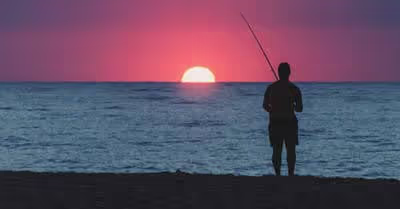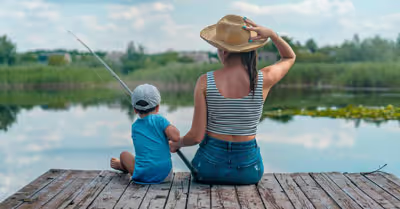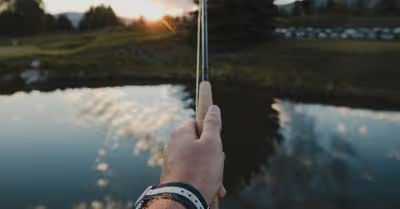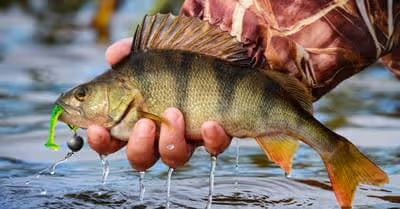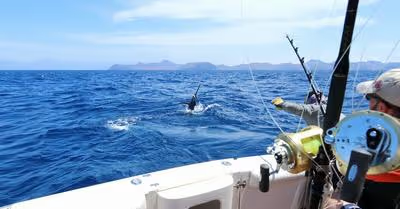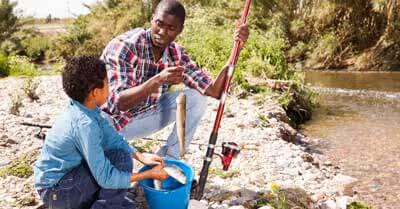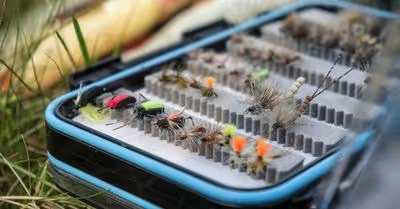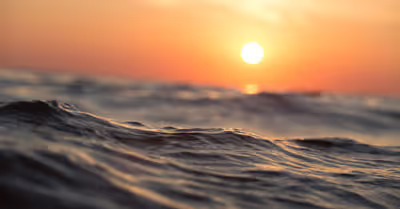Table of Contents
What Determines the Best Fishing Spots?
When fishing in such environments, it's essential to remember that various fish species require different environmental conditions. Such factors include salinity, water temperature, current, and dissolved oxygen, water depth, foods available and hiding areas, among others.
When you visit a pond, look for spots such as lily pads, downed trees, and docks or weed edges. Such locations have one thing in common; they offer shelter, cover, and shade to fish. Other structures you should try and locate include stumps, branches, coves, overhanging trees, and inlets. Concentrate on fishing close to the shoreline or any structures on these water bodies.
Let's look at some of the most popular spots where you can fish in lakes and ponds.
Points
A point starts from the shoreline and inclines gradually into deeper water. These are ideal places to fish in lakes and ponds. Remember, you should only fish in points featuring a drop-off or those extending into deeper water. The sloping-out formation creates a high where fish move from deeper to shallow water.
Weed Beds
Weed beds also offer shelter and food to baitfish, consequently attracting the bigger fish to such spots. In lakes and ponds, try and locate sunken weed beds and weed beds that lead to deeper waters. Fishing in weed beds, especially on the edges, is a sure way of getting a decent catch. Fish love moving along these edges as they scout for food.
Inlets
A stream or river feeds a majority of ponds and lakes. These sources serve as inlets to the water bodies. Fish usually congregate at these points as they gamble for the food getting in. Such places are perfect areas to fish. When fish are moving upstream to spawn, they usually gather close to the inlets.
Submerged Objects
Anglers on lakes and ponds always look for downed trees or other submerged objects since fish prefer to shelter and hide in such locations. These objects host insects that attract baitfish and, ultimately, the game fish. Other submerged items to watch out for include stumps, rocks, and branches.
Lily Pads and Floating Weeds
Aquatic creatures and insects are abundant in lily pads and floating plants. These attract baitfish and larger fish to these areas. Large patches of lily pads also offer shade to fish. If you decide to cast on these spots, you're more likely to get an incredible catch.
Docks
Docks are other excellent structures in lakes and ponds to fish. When it's hot, fish tend to shelter under docks. These locations are ideal fishing spots, no matter the time of the day. Consider fishing on the edges as well as under the docks.
Overhanging Trees
Birds usually find cover and shade on overhanging trees. Insects also drop form these trees to the water providing food to fish. Since overhanging trees provide shade and shelter to fish, they are suitable places to fish. Typically, most of the overhanging trees are just a few feet from the shoreline.
Brushy Shorelines
Brushy shorelines work similarly to overhanging trees. They provide shelter and shade to fish. They are also home to many insects that serve as food to fish. Most fish usually hide under bushes a foot or two from the shore.
Lake and Pond Fishing Techniques
When you embark on fishing in a lake or pond, it's vital to get acquainted with the best fishing techniques that will guarantee the best results. Fish abound in areas with high oxygen concentration and adequate cover to hide from predators. Some of the most popular fishing methods suitable for lakes and ponds include:
1. Trolling
Trolling is a fishing technique that utilizes one or more fishing lines with baitfish or lures drawn through the water. This can occur when you're winding the line while in a static position. It's also possible when moving a boat or sweeping the line from one side to another. This method is ideal for catching pelagic fish like kingfish, salmon, or mackerel.
When trolling, the boat moves slowly and quietly over the water via a unique trolling motor. If you use multiple lines, you're required to use outriggers to spread them widely and minimize tangling. The use of multiple lines is what separates trolling from other fishing methods. These lines are set at the back of the boat with the baitfish and lure lagging. Your boat can either be moving or static while drawing the line in or sweeping it side to side to entice the fish.
The equipment to use when trolling depends on the boat you'll be using and the probability of catching fish. Like other fishing techniques, you'll need one or several sets of fishing equipment. On the minimum, you'll require fishing lines, saltwater reels, and fishing rods.
For this technique, it's best to use specialized trolling rods in addition to non-corrosive reels and lines. But most importantly, ensure the basic gear can withstand heavy loads. In this respect, go for high tensile strength durable lines, sturdy rods, and high-load multi-roll bait casting reels featuring line counters. Other vital equipments you'll need when trolling include depth rigs, rod holders, planer board, paravane, and sonar
2. Bait Casting
Bait casting is another excellent technique you can use while fishing in lakes and ponds. This method uses the weight of the lure to spin out the line to the target location. Bait casting comprises a revolving-spool reel attached to the topside of the rod. This technique requires practice to perfect.
Initially, you may find challenges casting your lures to the right target, but with practice, you'll be able to cast them to spot where fish are hanging out or feeding. One of the main advantages of these methods is that you can use large lures and cast them in a more extended range.
In simple terms, casting is throwing your lure or bait using a fishing line to the water using a flexible fishing rod. You need to flick the rod from behind to the water. The casting technique depends on the fish you're targeting.
For example, fly fisher's man made lures alongside lighter lines and rods. They perfect their skills by monitoring hand and arm movements to increase accuracy by mimicking real flies.
On the other hand, saltwater anglers prefer heavier lines and rods. Typically, they use baits and lures, which are heavier when compared to ordinary flies. In surfcasting, heavier rods and lines are used. In such a case, you must use your entire body to deliver the cast instead of the arms and hands. This will enable you to cast your bait hundreds of feet.
Bait casting reels are available in varying capacities and sizes. They may also come in varying features. Most of these reels feature a horizontal spool onto which the line winds. These reels guarantee better control of the lure and line. They also offer better accuracy compared to other types of reels.
The best way of casting the reel is by pressing the push-button when you want to release the line. Be cautious when casting these reels since they do backlash or snarl, especially when you're new to this task. This occurs when the line comes off the reel at high speed. Upon the lure hitting the water, the line stops. Unfortunately, the spool continues to run, leading to a snarl-up. It's most common when fishing under heavy winds.
The best way to limit this problem is by practicing casting reels. Most bait casting reels have a brake to minimize snarling. In this case, the spool and line stop automatically at once. For the low-profile bait casting reels, you have to use a thumb to stop snarling.
Although in bait casting, you can use the same lures as in trolling; you have to handle them differently. You have to keep repeating the casting and retrieving motion. The aim is to take the fish while your lure is in motion. In bait casting, you vary the speed at which you present the bait to the fish, but in trolling, the speed is constant.
Although luck may play a role in succeeding in bait casting, you must take time to develop your skills. For example, on a hot day, when fish are lying deep in the water, you may be unsuccessful catching fish if you use a surface plug even if you consistently retrieve it fast with a uniform motion.
On the other hand, your colleague may succeed catching fish if they are using a deep-running plug and retrieving it slowly via a hesitating movement. The difference comes in since you're trying to attract fish to your spot while your fellow angler delivers the lure down to the fish.
In this case, you understand, it's essential to cast your bait at the right depth and adopt a retrieving movement that attracts fish to strike. Practice extensively on baitcasting to master the best way to cast baits.
The plugs used in baitcasting are designed for use in varying depths. For example, top-running and surface plugs usually float. They produce a more noisy action beside they kick up a splash as they move. This assists to entice fish more so at dusk or dawn when fish are feeding in shallow water.
The shallow-running plugs work perfectly just below the surface of the water while deep-running plugs are fished down deep in water.
When casting, it's vital to monitor your movements. You can make a plug act like a wounded minnow or a darting fish by evoking erratic retrieve. Rather than reeling steadily, allow the plug to sink for a while before retrieving. In the process, continually real and pause as you manipulate your rod's tip up and down. Experiment on various types of retrieves to determine which yields the best results.
After each cast, it's advisable to move your lure to the boat before lifting it out of the water. This is because some fish may be following your bait and may go for it while you want to lift it out of the water.
When bait casting, use various tactics, especially when using live baits. In this, you can determine what makes fish tickle. Once you locate the best method, stick to it. If the technique no longer works, try another.
3. Still Fishing Technique
Still fishing is one of the simplest yet effective techniques you can use when fishing lakes and ponds. This method is popular among beginners and professional anglers. If you practice the method, you'll enjoy catching more fish. You don't have to take ages to master this method. A few trips to the lake or pond will be sufficient.
This method involves plunking your bait in the water and waiting for fish to locate it. If you're a beginner, you'll have an easy time using the technique due to its simplicity. It may also prove challenging when fly fishing since the fly rod may disturb the surface of the water when retrieving/scaring the fish.
Stillwater fishing also referred to as still fishing, is a versatile way of fishing and can be done from a bridge, boat, and pier or shore. You can also still fish off the bottom in lakes, ponds, streams, and rivers for a variety of species. You can practice this technique nearly at any season of the year or time of the day.
The fish you're targeting in still fishing determines the bait to use and the size of your hooks. For example, midges are considered among the best flies for Stillwater fishing trout in winter. But remember your ideal equipment in still fishing is patience. You must be patient enough for the fish to bite.
You can still fish on the bottom, mid-water, depth or on the surface of lakes and ponds depending on the fish you're targeting. You can easily fish on the surface by using a bobber or a float. On the other hand, sinkers will enable you to fish deeper.
Although some fishing methods can be complicated, the basics remain constant. What you need is to have a line, reel, bait, and sinkers. This, too, applies to still fishing. You don't need to spend lots of money to acquire fancy fishing gear. The most crucial aspect is mastering the tricks which yield the best results.
If you want to succeed in stillwater fishing, you can talk to seasoned anglers on the best way to approach the technique. As long as you're willing to learn, you'll have minimal challenges using this method.
The best spots to still fish are locations that seem somewhat different from the surroundings. Look out for areas in ponds and lakes where there's slight current, a change on the bottom or little cover. Any place that seems to be an attractive feeding ground for fish will offer excellent results to your efforts. Most places that appear as holding grounds for fish are perfect for still fishing.
Tips for Succeeding in Lake and Pond Fishing
First, it's essential to purchase the right equipment besides locating the ideal fishing spot. You should also know the best time for fishing. As you know, fish are cold-blooded creatures, and they usually retreat to deeper waters when it's very hot or become inactive when it's cold. Dusk and dawn are the best times to fish in a lake.
Also, consider the pressures, tides, weather, and other natural events when choosing the best day to go fishing. When you arrive at the lake or pond, it's time to move around and identify the best fishing spot beside the best strategy.
Consider implementing the above techniques when setting out for your next fishing expedition in a lake or pond. Besides, consider fishing on spots where fish are more likely to abound as highlighted. Also, consider seeking tips from experienced anglers.
Final Words
Fishing in lakes and ponds is an excellent opportunity to spend time with family and friends. It's also an exciting avenue for professional anglers to exercise their trade. Learning and practicing various techniques suitable for these locations is the best way of overcoming any associated challenges.
In the last five decades, fishing technology has advanced significantly. Boat capacity is increasing, and the ability to locate and catch fish has also improved. Advances have also been made to minimize the impact of fishing on the environment. Fishing methods vary on the cultures, locations, and impact they have on the environment. Experiment on the techniques and adopt what works best for you.
Recent Articles



